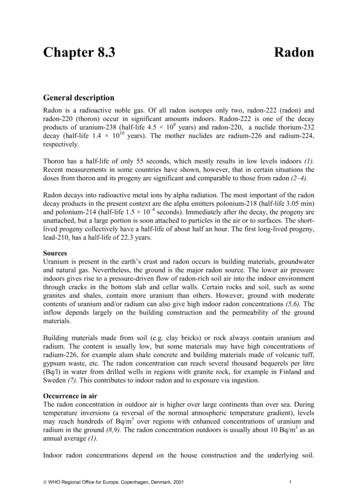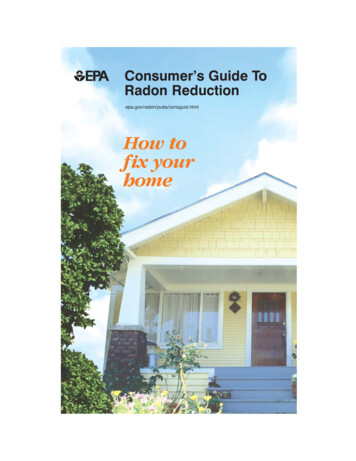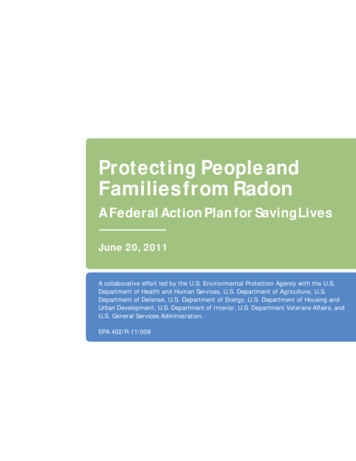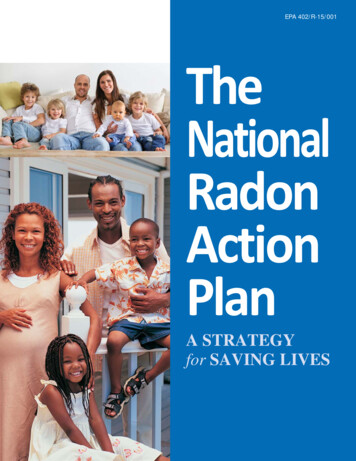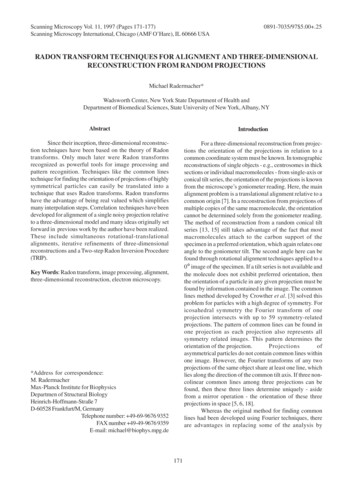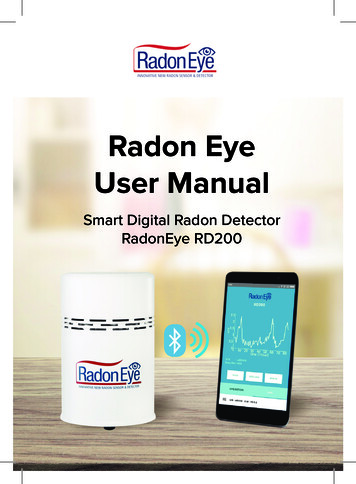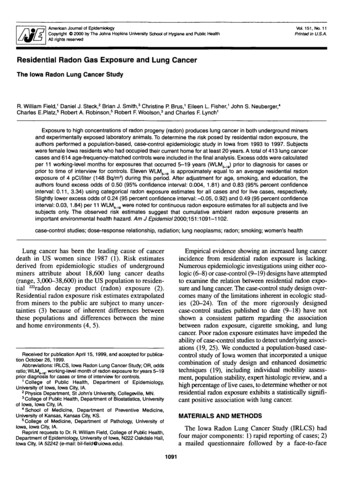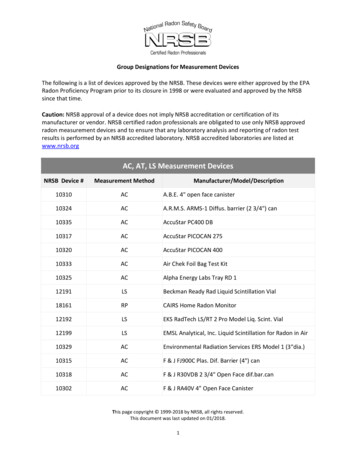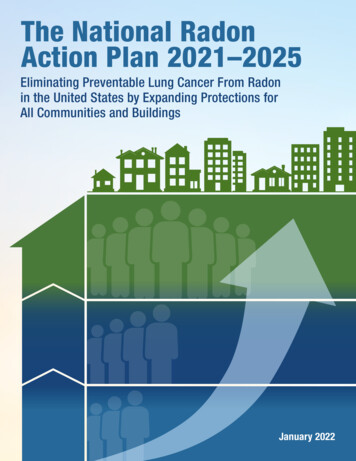
Transcription
The National RadonAction Plan 2021–2025Eliminating Preventable Lung Cancer From Radonin the United States by Expanding Protections forAll Communities and BuildingsJanuary 20221
Eliminating Preventable Lung Cancer From Radonin the United States by Expanding Protections forAll Communities and BuildingsRadon Is the Leading EnvironmentalCause of Lung Cancer Death1Radon exposure leads to more lung cancer deaths everyyear than any other environmental source in the UnitedStates—an estimated 21,000 lives are lost to lung cancerfrom radon each year.2Radon is a radioactive, odorless, invisible gas that is foundin soil and rocks. It seeps undetected into cracks and gapsin buildings, where it can be present in high concentrations.Because people spend most of their time indoors, highlevels of radon can put their health at risk. The only wayto find out if indoor air has high radon levels is through asimple test.When dangerous levels of radon are found indoors,the solution can be quite straightforward. Qualifiedprofessionals can install a system that prevents highlevels of radon from accumulating inside the building. Newbuildings can be designed and built using radon-resistantconstruction techniques. These efforts save lives today andinto the future.Despite 40 years of clear evidence that radon exposureindoors can cause lung cancer and undisputed knowledgethat proper testing and mitigation can greatly reduceexposure, too many Americans still die from radon-inducedlung cancer every year. Tragically, most never knew theyfaced a risk from indoor radon before receiving a lungcancer diagnosis.The key steps to reduce radon-induced deaths from lungcancer are to increase public awareness of the threat,test all types of buildings for elevated radon levels, build aworkforce of credentialed radon professionals who can fixradon problems following proven-effective standards, andensure the availability of adequate funding to pay for testingand repairs.people of color and by those with low incomes are lesslikely to have their homes tested for radon than others.3Some people are not aware that exposure to indoor radoncan cause lung cancer and that testing for radon is easy.Others may face challenges protecting their homes becausethey are renters or because they cannot afford the costof radon testing and mitigation. Because repairing highradon in homes and other buildings is expected to resultin important health benefits, access to life-saving radonprotections must be made more equitable.The Solution Is StraightforwardThe benefits of fixing indoor radon to prevent lung cancersare enormous. For example, it is estimated that withintypical multifamily housing, every dollar spent on radontesting and repairs returns 11 to 20 in avoided healthcare costs. More importantly, fixing radon levels couldsave years of healthy life for affected citizens.4 Findingand fixing high radon is an excellent investment in thehealth of our nation. It requires coordinated action fromsectors and industries that, at first glance, may notappear to have strong points of intersection or overlappingmissions—environment, housing, public health, real estate,development, finance, energy, service providers, healthcare, radiation science and others.Under the inaugural National Radon Action Plan (NRAP)and this National Radon Action Plan for 2021–2025(NRAP 2021–25), leaders from across multiple sectorshave worked together for more than a decade to plan,guide and sustain nationwide radon action in an effort toprotect every building in every community. With the costs ofradon so great, the benefits of investment so clear, and thetechnical solutions to improve health so straightforward andavailable—it has never been more important to continue todrive action.Radon Is a Health Equity ChallengeCoordinating National Radon Action SavesLives: NRAP and NRAP 2021–25Although radon is a potential risk in all communities, andEPA recommends that all buildings be tested, there isevidence that the benefits of radon risk-reduction measuresare not equally shared. Homeowner households led byNRAP 2021–25 is the third installment of a strategyanchored by the U.S. Environmental Protection Agency (EPA)to ramp up action on radon. The Federal Radon Action Plan(FRAP), released in 2011, directed an expansion ofThe National Radon Action Plan 2021–20252
government financing toward radon and spurred testingand repairs by certified professionals in additional federallyowned or assisted buildings. The FRAP also solidified federalpartners’ commitment to (1) the development of AmericanNational Standards for radon testing and mitigation in allbuilding types, (2) multi-agency efforts to explore the effect ofenergy upgrades on indoor radon levels, and (3) public healthleadership to encourage state cancer control programs toexamine radon risks and solutions.These federal efforts attracted the attention of nationalchampions eager to save more lives more quickly fromradon-induced lung cancer. In 2015, a 12-memberprivate–public partnership of industry; FRAP federal agencyleaders; and health, housing, radiation, energy, cancer andbuilding science experts joined under the leadership of theAmerican Lung Association to launch the NRAP.As in the first NRAP, the strategies in NRAP 2021–25remain focused on actions that will save lives by fixingbuildings, constructing buildings with radon-resistantfeatures, and preparing a certified, professional radonworkforce. The Plan spotlights addressing radon as ahealth equity challenge and prioritizes new strategies toreduce radon risk in underserved communities, includingcommunities of color. NRAP 2021–25 also prioritizes workthat can be measured in lives saved and emphasizes theneed to continuously improve the quality of and access toreliable data to quantify NRAP progress, radon risk reducedand national rates of lung cancer from radon.We invite leaders who areserious about—The NRAP Leadership Council unites different perspectiveson the challenge of finding and fixing preventable radonexposures. The Council has sustained its collaboration toguide national radon action for the decade (2015–2025).The NRAP Leadership Council takes seriously the need toaccelerate progress with every iteration of the NRAP (seethe report Reflections on the NRAP’s Progress, 2015–2020).In 2021, the NRAP set a goal for the nation to find,fix and prevent high indoor radon levels in 8 millionbuildings by 2025; prevent an average of at least 3,500lung cancer deaths per year; and save one-quarter of amillion lives in those buildings during the next 74 years.5 saving lives building in health protection wherewe live, work and learn eliminating preventable disease realizing a high return oninvestment in a healthier future—to join the NRAP LeadershipCouncil. AcronymsANSIAmerican National Standards InstituteHHSU.S. Department of Health and Human ServicesDOEU.S. Department of EnergyHUDU.S. Department of Housing and Urban DevelopmentDOIU.S. Department of the InteriorUSDAU.S. Department of AgricultureEPAU.S. Environmental Protection AgencyVAVeterans AdministrationFHAFederal Housing AdministrationWxWeatherization Assistance ProgramGSAGeneral Services AdministrationThe National Radon Action Plan 2021–20253
BUILDINGSPROTECTED(IN MILLIONS)8 Millionby 2025NRAP 2021–2025Build In RadonRisk ReductionNational LeadersExpand Strategiesto Save Lives inAll Buildings Lenders require tests intransactions. Radon risk is disclosed intransactions. Codes require radoncontrols.Support RiskReduction Radon testing and mitigationare eligible expenses undertax incentives. Funds for radon controls forlow-income owners exist.Build CapacityUsing ProfessionalRadon ServicesIncreaseAwareness Robust data on nationalradon risk exists. Partners increase focus inoccupant health and radon. Radon credentialingapproaches are aligned. Health equity partners areengaged. Tailored risk informationfor underserved groupsexists. Radon is in all cancercontrol plans.3.8 Million2020NRAP 2015–2020Public–PrivatePartnership Buildson Federal Action HUD expands radon requirements inmultifamily and residential care facilitymortgage insurance programs and FHA loans. Progress with building codes is achieved. Precautionary steps for radon are adoptedby Wx. Precautionary stepscreated for Wx arerequired in somegreen and healthyhomes programs. ANSI standards arefinalized for all buildingtypes. Radon is named in 85%of state cancer controlplans. FHA references ANSIfor radon in newrequirements. Physician’s guide forradon is released andpromoted to oncologists. Funding is secured for grants to supporttesting and mitigation in HUD public housing.1.6 Million2015FRAP 2010–2015Federal AgenciesRamp Up RadonAction HUD, USDA and VA approveradon expense. DOI and GSA testbuildings. HUD creates new radontesting and mitigationrequirements for somemultifamily housing mortgageinsurance programs in 2013. EPA supports developmentof ANSI standards for allbuilding types. DOE tests radon in Wx.6 HHS focuses on radonin environmental healthtracking and cancer controlprograms. Please see page 3 for a list of acronyms found in this graphic.The National Radon Action Plan 2021–20254
NRAP 2021–25’s Four Goal Areas forSaving Lives From RadonAfter 5 years in partnership, the NRAP Leadership Councilcontinues to collaborate, sharing ideas about how bestto move critical, life-saving radon action forward. Thismultisector group shares the work—each memberorganization leading in its area of knowledge, responsibilityand capacity—to advance four related priorities that they allshare for saving lives from radon.Build In Risk ReductionRules, codes and standards that govern how buildings arefinanced, developed, constructed and maintained provideopportunities to require and invest in radon testing andrepairs. Wherever possible, the NRAP calls for embeddingradon testing, remediation and construction provisions intothese requirements to integrate radon risk reduction as astandard practice in ongoing work.In NRAP 2021–25, Goal Area 1 seeks to include radonrequirements within real estate, including rental andmortgage transactions for all types of buildings. The goalis to maximize risk reduction for all buildings by testing,sharing information about and reducing radon risksthrough repairs when building transactions occur betweenhomeowners or between landlords and renters, or whenrepairs and rehabilitations and construction projects arefinanced. The Plan remains focused on the enormouslife-saving potential of protective building codes torequire radon controls in new buildings and of testingand repairs of existing buildings as needed, particularlyfor schools and rental properties.Support Radon Risk ReductionPeople who have control of their built environments andcan afford to test for and reduce high radon levels canbe encouraged to address the risk through educationand incentives. For them, the NRAP aims to spur radonaction by making it obvious and easy. For others, however,educational messages alone are not sufficient to initiateaction. Many people do not have the authority to test andrepair the rental housing, workplaces and schools that theyThe National Radon Action Plan 2021–2025occupy, and even for those who do, the cost burden ofrepairs may be too great. Funding support from legislativeand health care budgets, along with grants and charity, willbe needed to cover the cost of radon testing and repairsin all buildings to eliminate preventable lung cancer fromindoor radon.In NRAP 2021–25, Goal Area 2 focuses on the criticalneed for increasing access to government-backed andother sources of housing financing, identifying newfunding sources and help for states and tribes to fundradon controls in all buildings—especially in lowincome communities and communities of color—anddirecting cancer prevention resources toward radonrisk reduction. The Plan focuses on outcomes that canbe connected to preventable cancers from radon. Theseoutcomes include working with state cancer controlprograms to expand radon policies; new financing andfunding flowing to more testing and repairs of highradon in low-income properties; and rising priority forradon action in federal, state and philanthropic healthpromotion investments.Build Capacity to Test and MitigateUsing Professional Radon ServicesConsensus standards and guidance now exist to governradon testing, mitigation, laboratory quality assurance andnew construction methods in all buildings—all home types,schools and large buildings, and occupational settings.Radon work requires rigorous training and standards-basedcredentialing in accordance with the American NationalStandards Institute to ensure that service providers areequipped to assess radon levels, make decisions aboutmitigation, and, when necessary, install mitigation systemsthat save lives from lung cancer by reliably preventing radonfrom entering buildings.In NRAP 2021–25, Goal Area 3 builds on NRAP successby seeking to spread recognition of the standardsnationwide and facilitate identification of a qualifiedworkforce by aligning current credentialing approachesto one quality standard. The Plan prioritizes improveddata collection and analysis, envisioning a landscapein which radon work can be counted on to save livesbecause it is conducted by credentialed professionalsfollowing national standards, and where annual radonrisk reduction can be reliably estimated using a robust,nationally representative dataset.5
Increase Awareness of Radon Riskand Control StrategiesEach year an estimated 21,000 people die from lungcancer caused by radon exposure, yet hundreds ofthousands of Americans are still breathing in high levelsof radon in buildings where they live, work, study and play.The risk from radon also disproportionately affects lowincome households not able to test for radon and fix whennecessary, the same population that suffers from poorerhealth and greater exposure to other residential hazardscompared to more affluent individuals. The first NRAP aimedto expand coordinated messaging and outreach on radonrisks across all types of buildings through trusted sources,such as health care providers and schools. Progress in thisarea was limited and still needs expansion.Looking Ahead With NRAP 2021–25In 2021, the NRAP Leadership Council affirmed itscommitment to expand national efforts to eliminatepreventable lung cancer from radon in the United States.In implementing NRAP 2021–25, the Council will look forstrategic opportunities to guide the use of existing tools,standards, smart financing and investment to save lives;support a strong buildings workforce; and eliminate preventableradon-induced lung cancers with an increased focus on lowincome communities, racial and ethnic minorities, tenants,employees, and children. NRAP 2021–25 goal areas,strategies for action and target outcomes for the next 5years are shown in Table 1 below.In NRAP 2021–25, Goal Area 4 seeks to addresshistoric inequities in knowledge of radon risk andopportunities for risk reduction through increasedengagement of intermediaries with responsibility forprotecting constituents’ health in homes, workplaces,schools and childcare settings. The strategies in thePlan include outreach to target audiences that have nothistorically played a role in radon risk communication,such as social service providers, faith leaders andhealth care providers, including federally qualified andcommunity health centers.The National Radon Action Plan 2021–20256
TABLE 1. NRAP 2021–25: STRATEGIES FOR EXPANDING PROTECTIONS FOR ALL BUILDINGSGOAL AREANRAP STRATEGIES, 2021–25OUTCOMES WE SEEKBuild In RadonRisk Reduction1.1 Embed comprehensive radon notifcation and health riskwarning statements, and radon test result disclosure, inreal estate sales and rental transactions.Prospective buyers, tenants and loan borrowers receive andacknowledge receipt of information that equips them to take selfprotective actions, including obtaining radon testing and mitigation.1.2 Work with government, quasi-governmental and privatesector lending entities to adopt radon testing andmitigation requirements.Lending entities require radon testing and mitigation in allresidential, educational and commercial buildings.1.3 Promote radon control requirements for newconstruction within building codes and standards.State and local building codes require that buildings be built toallow for radon control.1.4 Seek local, state and federal policies and codes thatrequire all existing buildings to be tested for radon andmitigated as needed.Building owners and managers, employers, and school districtsensure that the radon levels in their buildings are protective ofoccupant health.Support RadonRisk ReductionBuild Capacity toTest and MitigateUsing ProfessionalRadon ServicesIncreaseAwareness ofRadon Risk andControl Strategies2.1 Increase access to government-backed and otherProperty owners are able to obtain fnancing for radon testing andsources of housing fnancing for property owners of low- mitigation in low-income housing from new and existing fundingincome housing to cover radon testing and mitigation.sources.2.2 Support establishment of tax incentives to cover radonmitigation costs.Tax incentives exist that increase voluntary radon testing andmitigation.2.3 Increase radon testing and as-needed mitigation bylocal, state and tribal programs that conduct physicalupgrades of existing housing.Radon testing and mitigation is routinely addressed by housingrehabilitation, home repair, energy upgrade, weatherization andsimilar programs.2.4 Support state cancer control programs to include radonindicators and interventions.All state cancer control programs include radon risk-reductioninterventions in their primary prevention strategies for lung cancer.Decision-makers nationwide have access to a robust national data3.1 Expand the scope and usability of radon testing dataset for use in characterizing radon exposures, quantifying riskin the National Environmental Public Health TrackingNetwork by increasing the number of participating states reduction actions and informing a research agenda.and laboratories.3.2 Continue to promote adherence to consensus standardsfor testing, mitigating and measurement deviceaccuracy.Quality professional standards to support the effectiveness ofradon services are widely recognized, disseminated and adopted.3.3 Support issuance and implementation of a federalframework to align private and state radon credentialingprograms.A clear standard of quality for assessing radon service providercompetencies and skills is widely recognized and adopted, andcredentialing programs are more consistent in standards andpractices used to license and certify service providers.3.4 Promote the adoption of radon credentialing by statesthat do not currently regulate radon service providers.Radon testing, mitigation and laboratory services nationwide areprovided by credentialed professionals.3.5 Expand the availability of credentialed radonpractitioners through the training and certifcation ofqualifed professionals.Credentialed radon professionals are available nationwide to meetincreasing demand.4.1 Promote integration of radon into coordinatedmessaging to decision-makers about health risks inhousing, schools and workplaces.Decision-makers with responsibility for occupant health in housing,schools and workplaces include radon risk reduction in theirpolicies and practices.4.2 Promote radon awareness through nontraditionalradon stakeholders—including clinical, health equity,social service and faith-based organizations—throughconsistent outreach using targeted materials.Nontraditional radon stakeholders educate and equip theirconstituents to take radon risk-reduction action.4.3 Tailor effective radon messaging to underserved racial,ethnic and low-income populations.Culturally competent information about radon risk reduction isavailable to underserved racial, ethnic and low-income groups.The National Radon Action Plan 2021–20257
Endnotes1 2 range of lives saved. Industry members of the NRAP believethat the percentage of homes that would test above the actionlevel of 4 picocuries per liter of air (pCi/L) for radon in Zones1 and 2 is 18–22%, and this assumption grounds the highend of the estimated range of lives saved. Additionally, radonlaboratory data collected by the Centers for Disease Controland Prevention in its Environmental Health Program Trackingdatabase since 2016 indicate premitigation radon prevalencecould be considerably higher, with 37% of homes in thedatabase testing above the EPA action level. It is important tonote that there is no peer-reviewed citation for the latter twoestimates at this time. The cost-benefit analysis is based on acurrently unpublished draft 2020 EPA memorandum developedto estimate the impact to date of expanded radon requirementsin FHA 5/documents/402-r-03-003.pdf.3 4 56 UESPA. 1992. Technical Support Document for the 1992Citizen’s Guide to Radon. EPA-400-R-92-011. Washington,D.C.: USEPA. nepis.epa.gov (enter 400R92011). rogram.The National Radon Action Plan 2021–20258
HUD, USDA and VA approve radon expense. HUD creates new radon testing and mitigation requirements for some multifamily housing mortgage insurance programs in 2013. DOI and GSA test buildings. EPA supports development of ANSI standards for all building types. DOE tests radon in Wx.
